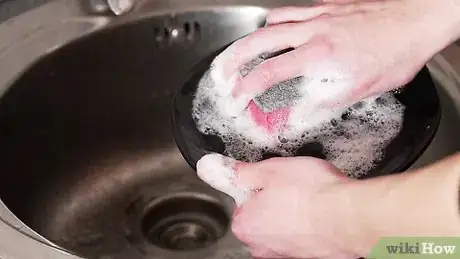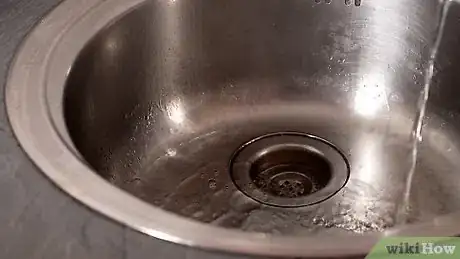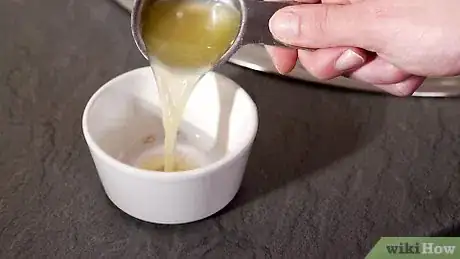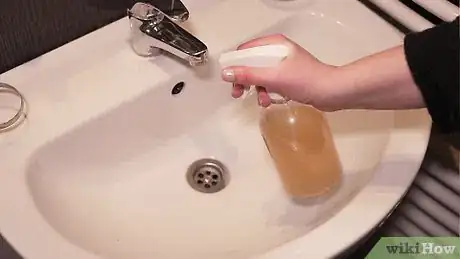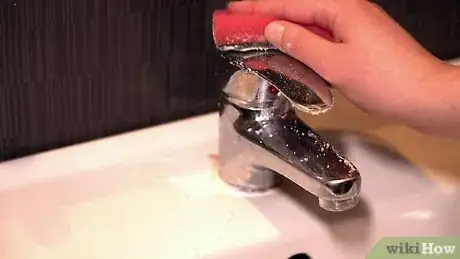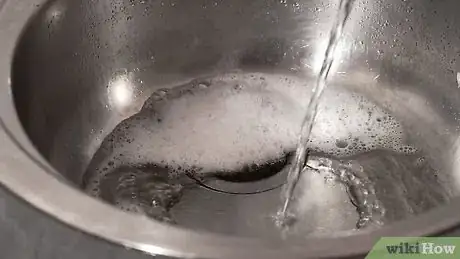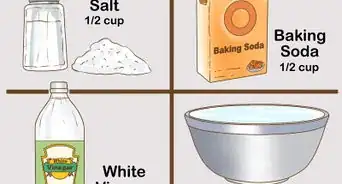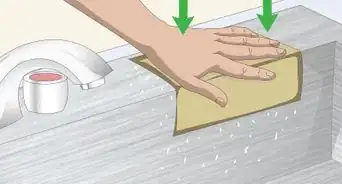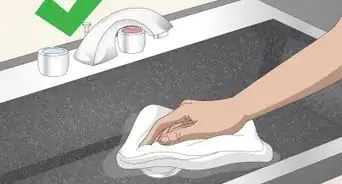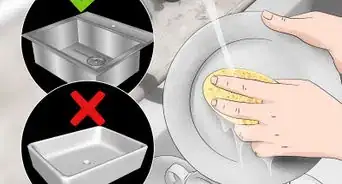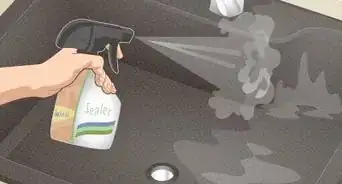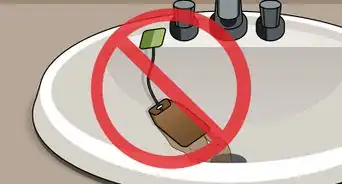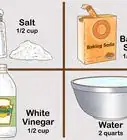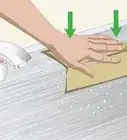This article was co-authored by Raymond Chiu. Raymond Chiu is the Director of Operations for MaidSailors.com, a residential and commercial cleaning service based in New York City that provides home and office cleaning services at affordable prices. He has a Bachelors in Business Administration and Management from Baruch College.
This article has been viewed 190,601 times.
Kitchen sinks are among the most used items in your household. It's no wonder, then, that they can also be the dirtiest. Left unclean too long, the bacteria that manifest in the sink can lead to life-threatening illnesses.[1] However, by effectively incorporating non-harmful cleaning products like baking soda, lemon juice, vinegar, and old-fashioned elbow grease, your kitchen sink, whether it's stainless steel or the more stubborn porcelain, won't stand a chance. A fresh and clean sink is on the way.
Steps
Cleaning a Stainless Steel Sink
-
1Remove and clean any dirty dishes and leftover food from your sink. There should be nothing in it as you begin scrubbing your sink. Remember to clean items that you keep in or around your sink, too. Move your sponge holder and drain stopper to get a more thorough clean.
-
2Wash down the entire surface area of your sink. Use a gentle soap, soft cloth, and warm water to clean the faucets, drain, and outer rim. Do this every time you use the sink, which includes after preparing meals or washing dishes.Advertisement
-
3Run hot tap water into the drain. This will help eliminate bad odor and soften any gooey materials that may threaten to clog the drain. Alternatively, boil a pot of water and pour that down, as it will help loosen any caked-on gunk in your drain. Be sure to wet down the entire sink through this process. Do this several times a week.
-
4Create a blend of baking soda and lemon juice for the surface. Mix 1 teaspoon of baking soda to 1/4 cup of lemon juice and pour it over the surface of your sink. Let this mixture stand for approximately 10 minutes before rinsing it away with hot water. Do this to your sink at least once a week. Baking soda is a natural cleaning agent that breaks down dirt and grease, so feel free to sprinkle it on cracks and harder-to-hit places, such as around the faucet and handles, and scrub at it with a toothbrush.
-
5Create a larger blend of baking soda and lemon juice for the drain. Mix 1/2 cup of baking soda with 1/4 cup of lemon juice. Pour this directly into the drain, and follow it with 1/2 cup of white vinegar. Cover it and wait 5 to 10 minutes. Meanwhile, boil some hot water and pour it in. The reaction of the cleaning products will help break up gunk and sanitize the drain, and the hot water will rinse it before it forms again.
-
6Use flour to polish the sink. Completely dry the sink with a towel. Any wetness left over will become like a paste when mixed with the flour. Sprinkle flour around the sink. Using a new, clean towel, slowly buff around the stainless steel in circular motions (the way you might wax a car). Remove the excess flour and throw it away.
- 1/4 cup of flour works great, but it isn't essential that you measure it.
- Repeat this process as you see fit. It may take a few times before it glistens.
Cleaning a Porcelain Sink
-
1Wash down the surface with a gentle soap and warm water. This will sanitize your sink in preparation for cleaning. Vinegar works as an alternative disinfectant to more harmful things like bleach, although it removes less bacteria than dish soap or bleach.[2]
-
2Spray the sink with hydrogen peroxide. Completely cover the surface and wait anywhere from 15 minutes to a few hours (the longer you wait, the more stains it will lift). Hydrogen peroxide has bleaching properties in it without the eye-watering smell. Rinse this away using warm water. It should take some of the stains with it, but if not, give it a bit of a scrub and rinse.
-
3Pour some baking soda over the surface. Dampen a sponge and apply a bit of elbow grease. The baking soda should foam up a little bit, which will creep inside some of the cracks to loosen the dirt, which you can then wash away. Again, use a toothbrush to reach into small cracks.
-
4Use lemon juice and salt on any remaining stains. Pour small piles of salt onto any remaining stains. Cover each salt pile with the juice of half of a lemon (or more if needed). Let it sit for about 5 minutes, and then scrub it with a clean piece of cloth or a sponge. Be aware that the salt may scratch the porcelain if you scrub too hard and the porcelain is delicate and new.
-
5Polish the porcelain with lemon oil. Place 3 to 4 drops of lemon oil onto a dry cloth and wipe it around the sink. Add more if necessary, using only a couple drops at a time. Besides smelling fresh, the oil helps to keep soap from resting on the surface and building up, keeping future cleanup much easier.
Keeping the Sink Clean
-
1Clean your dishes regularly. If you don't have a dishwasher, it can be easy to let dishes go for a day or two (or longer). Letting dishes sit around, whether in the sink or in the dishwasher, can spread harmful bacteria at a rapid rate.[3] If you can't get to them immediately, let them soak to ease the process when you get to them, but try to limit it to an overnight soak.
-
2Pour hot water down the sink after washing dishes. This will ensure that any gunk immediately in the drain will wash away before it solidifies, making it harder to remove later.[4] Alternate between using very hot tap water and boiling water. This will also prevent odors from forming.
-
3Create a disinfectant spray. Mix 1 cup each of water and white vinegar or apple cider vinegar along with juice from half of a lemon to help cut away grease and ward off harmful bacteria. Instead of lemon, try using 20-40 drops of a lemon-based essential oil (or other oils with similar properties, such as tea tree, orange, or lavender).[5] Keep this on hand to spray down your sink after you finish washing dishes.
How Do I Clean Kitchen Tiles?
Expert Q&A
Did you know you can get expert answers for this article?
Unlock expert answers by supporting wikiHow
-
QuestionHow can I clean gunk out from my sink?
 Raymond ChiuRaymond Chiu is the Director of Operations for MaidSailors.com, a residential and commercial cleaning service based in New York City that provides home and office cleaning services at affordable prices. He has a Bachelors in Business Administration and Management from Baruch College.
Raymond ChiuRaymond Chiu is the Director of Operations for MaidSailors.com, a residential and commercial cleaning service based in New York City that provides home and office cleaning services at affordable prices. He has a Bachelors in Business Administration and Management from Baruch College.
House Cleaning Professional
-
QuestionMy drain seems to have a smell. I have used baking soda and vinegar mixture but it doesn't help. What else can I do?
 Community AnswerIf it's a garbage disposal put oranges, peel and all, in and turn it on. if it's just the drain take three oranges peel and the peels from six oranges, blend them to a liquid, pour it into the drain, and let set 30 minutes. Then run water into it. Repeat as needed. It gives your kitchen the smell of fresh oranges. Lemons or limes will work as well.
Community AnswerIf it's a garbage disposal put oranges, peel and all, in and turn it on. if it's just the drain take three oranges peel and the peels from six oranges, blend them to a liquid, pour it into the drain, and let set 30 minutes. Then run water into it. Repeat as needed. It gives your kitchen the smell of fresh oranges. Lemons or limes will work as well. -
QuestionHow can I remove scratches from stainless steel stove and sink?
 Free EagleCommunity AnswerTake a wet rag (old flour sack towels work best), wring it out, and fold it into 6 or 8 folds to make a nice pad. Apply Ajax or Comet powder cleaner on to the rag. Clean in the direction of the grain of the stainless steel. Then take a second rag, run it under hot water (as hot as you can stand), use this one to rinse off the Ajax/Comet, again working in the direction of the grain. Then imminently dry with a dry cloth - again in grain direction. Over time, the scratches will disappear.
Free EagleCommunity AnswerTake a wet rag (old flour sack towels work best), wring it out, and fold it into 6 or 8 folds to make a nice pad. Apply Ajax or Comet powder cleaner on to the rag. Clean in the direction of the grain of the stainless steel. Then take a second rag, run it under hot water (as hot as you can stand), use this one to rinse off the Ajax/Comet, again working in the direction of the grain. Then imminently dry with a dry cloth - again in grain direction. Over time, the scratches will disappear.
Warnings
- Do not allow the baking soda and vinegar to mix before pouring them down the drain. It is important that the chemical reaction takes place in the sink to work effectively.⧼thumbs_response⧽
- Never allow lemon juice to sit on the surface of an enameled sink for longer than 10 minutes at a time. The acidic nature of the juice will erode the enamel if left on too long.⧼thumbs_response⧽
- Never pour fatty cooking liquids down your sink drain.[6] These start as a liquid, because they are hot, but end as a solid mass once they cool down. Pouring hot grease or chicken fat in your sink can clog the drain and cause serious damage to the pipes.⧼thumbs_response⧽
Things You'll Need
- Water
- Gentle soap
- Soft cloth
- Old toothbrush
- Measuring spoons and cups
- Baking soda
- Hydrogen Peroxide
- Flour
- Whole lemon or lemon juice
- Salt
- White vinegar
- Abrasive cleaning pad
References
- ↑ http://www.webmd.com/women/home-health-and-safety-9/places-germs-hide
- ↑ http://www.livingonadime.com/vinegar-disinfect-as-well-as-bleach/
- ↑ https://www.urmc.rochester.edu/encyclopedia/content.aspx?contenttypeid=1&contentid=1220
- ↑ Raymond Chiu. House Cleaning Professional. Expert Interview. 15 October 2019.
- ↑ http://blog.radiantlifecatalog.com/diy-all-purpose-cleaner
- ↑ Raymond Chiu. House Cleaning Professional. Expert Interview. 15 October 2019.
About This Article
To clean a stainless steel kitchen sink, mix together 1 teaspoon of baking soda and 1/4 cup of lemon juice and pour this mixture all over your sink. Let it sit for 10 minutes before rinsing it with hot or boiling water. To clean the drain, mix 1/2 cup of baking soda with 1/4 cup of lemon juice. Pour this directly into the drain, and follow it with 1/2 cup of white vinegar. Cover the drain with a plug and let it soak for 5-10 minutes while you boil some water. After it has soaked, pour the boiling water down the drain. To learn how to clean a porcelain sink, read on!
